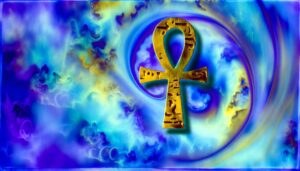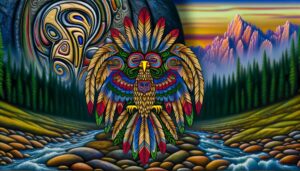Understanding the Meanings of Native American Bird Symbols
Native American cultural interpretations of birds offer deep spiritual and symbolic meanings. The eagle signifies strength, courage, and spiritual wisdom while acting as a sacred messenger.
Ravens symbolize transformation and hidden life mysteries, often seen as creators and shape-shifters. Hawks represent vision, intuition, and the need for awareness.
The Thunderbird embodies protection and powerful natural forces. Hummingbirds convey joy, resilience, and love.
Woodpeckers reflect determination and the significance of rhythm in life. Swans represent grace and spiritual growth, while Blue Jays epitomize clarity and communication.
Turkeys celebrate abundance and communal harmony. Each bird holds unique and intricate meanings, enriching their cultural tapestry.
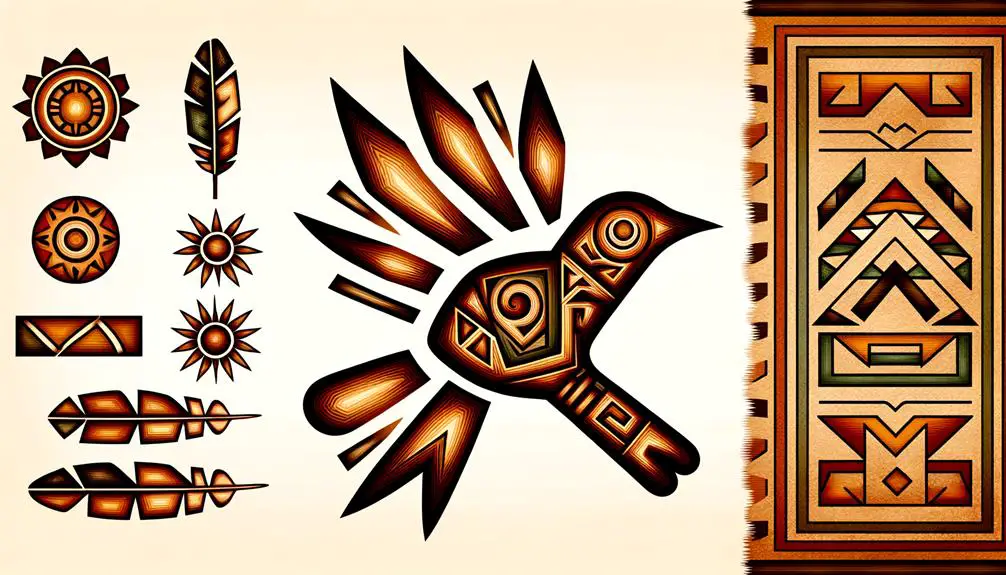
Key Takeaways
- Eagles symbolize strength, courage, and spiritual wisdom, acting as messengers between human and spiritual realms.
- Ravens signify transformation, change, and unseen forces, often viewed as creators and shape-shifters.
- Hawks represent vision and intuition, bridging physical and spiritual domains and encouraging heightened awareness.
- Thunderbirds symbolize strength, protection, and the power to create thunder and lightning, acting as guardians.
- Hummingbirds embody joy, resilience, and love, symbolizing energy, adaptability, and perseverance.
Eagle

The eagle holds a profoundly significant place in Native American culture, symbolizing strength, courage, and spiritual wisdom. Revered across numerous tribes, the eagle is often seen as a messenger between the human and spiritual domains. Its ability to soar at great heights embodies a connection to the divine, and its keen vision is metaphorically linked to foresight and clarity.
Eagle feathers, considered sacred, are used in various ceremonies and rituals to invoke protection and blessings. The eagle's presence in mythology and folklore underscores its role as a powerful totem, guiding and protecting those who seek its wisdom. This bird's revered status reflects its integral role in the cultural and spiritual tapestry of Native American life.
Raven
Within Native American traditions, the raven is frequently revered as a powerful symbol of transformation, embodying the complex interplay between life and death.
This enigmatic bird is often viewed as a messenger between the earthly domain and the spiritual world, bridging gaps and facilitating communication.
Its role in numerous tribal mythologies underscores the raven's significance in cultural narratives that emphasize change, renewal, and the unseen forces that influence human existence.
Symbol of Transformation
Revered among many Native American tribes, the raven symbolizes profound transformation and the ability to navigate through life's mysteries.
This bird is often associated with change, adaptation, and the power to alter one's state of being. The raven's black feathers and enigmatic presence evoke a sense of the unknown, making it a powerful symbol in tribal lore.
Tribes such as the Tlingit and the Haida view the raven as a creator and a shape-shifter, embodying the essence of metamorphosis. Its ability to thrive in various environments further underscores its role as an emblem of resilience and renewal.
Consequently, the raven serves as a potent reminder of life's perpetual cycles of change and the necessity of embracing transformation.
Messenger Between Worlds
Mirroring its role as a symbol of transformation, the raven is also revered as a messenger between worlds, bridging the earthly domain and the spiritual sphere.
In Native American cultures, the raven holds a significant place as a conduit for communication with the divine. This bird is often seen as an intermediary that carries messages from ancestors and spiritual entities to the living. Its black plumage and enigmatic nature contribute to its mystical reputation.
Stories and myths frequently depict the raven as a bearer of wisdom, guiding individuals through life's complexities and offering insights into the unknown.
This dual symbolism emphasizes the raven's unique role in connecting the physical and spiritual domains, underscoring its importance in Native American spirituality.
Hawk
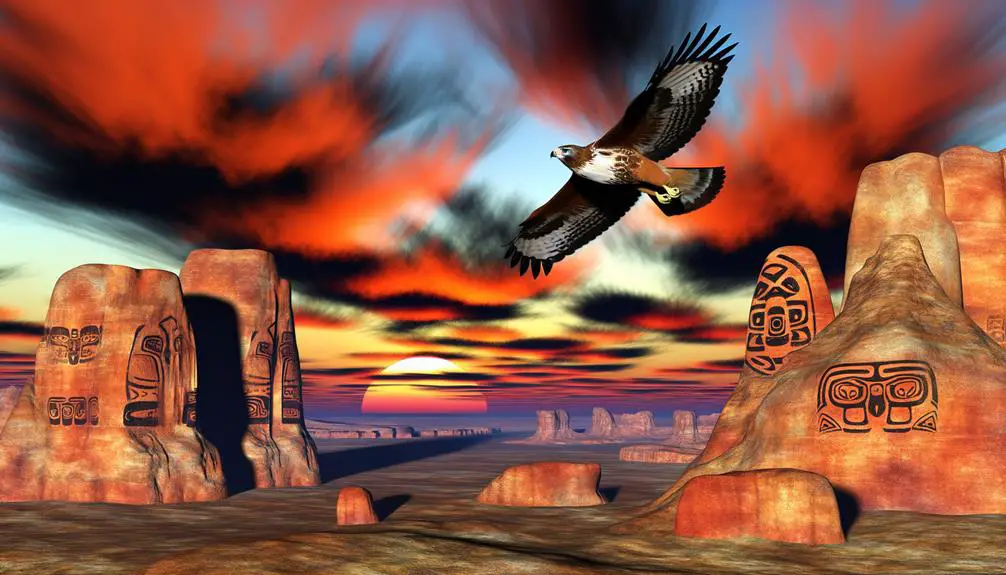
In Native American culture, the hawk is often regarded as a messenger and a symbol of vision and intuition. Revered for its keen eyesight and ability to soar high, the hawk represents a bridge between the physical and spiritual domains. Tribes believe that the hawk's presence signals the need for heightened awareness and insight. This powerful bird encourages individuals to trust their instincts and embrace foresight.
| Attribute | Symbolic Meaning | Cultural Significance |
|---|---|---|
| Eyesight | Vision | Enhanced perception and clarity |
| Flight | Intuition | Connection to spiritual guidance |
| Hunting Skill | Focus | Determination and goal-oriented action |
| Cry | Communication | Messages from the spiritual world |
| Presence | Awareness | Call for mindfulness and vigilance |
Understanding these attributes enriches one's appreciation for the hawk's profound symbolism.
Thunderbird
Among the many significant avian symbols in Native American culture, the Thunderbird stands out as a powerful emblem of strength and protection. Revered across various tribal nations, the Thunderbird is often depicted as an immense bird capable of creating thunder and lightning with the flapping of its wings.
This majestic creature embodies the duality of creation and destruction, symbolizing both the nurturing rains and the formidable storms. In cultural narratives, the Thunderbird is a guardian figure, often invoked in times of peril to ward off evil spirits and ensure communal safety.
Its representation varies among tribes, yet consistently highlights its role as an intermediary between the spiritual and physical worlds, reinforcing its status as a potent symbol of divine intervention.
Hummingbird
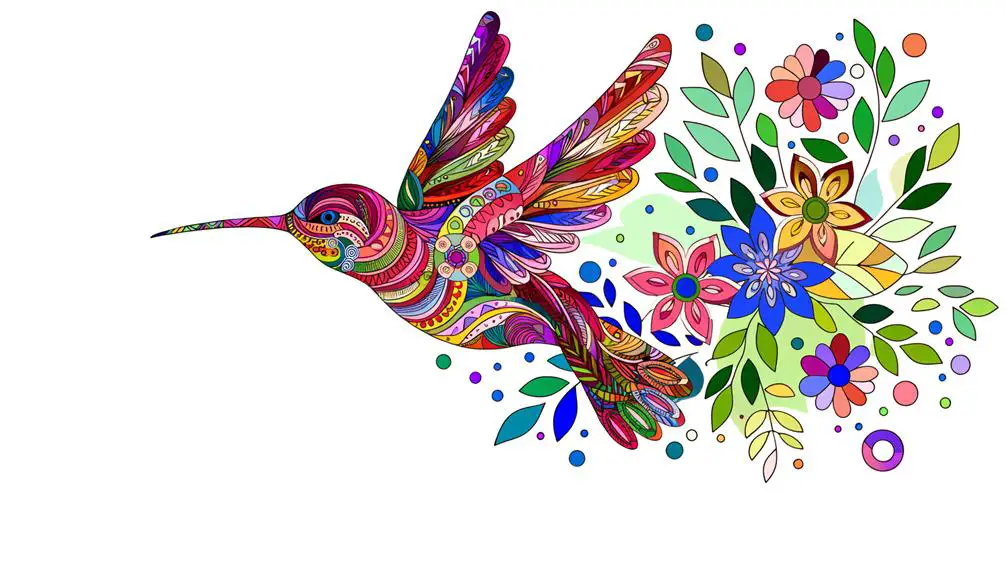
In Native American cultures, the hummingbird is revered as a symbol of joy, embodying the delight and energy found in nature.
Often regarded as messengers of love, these small yet vibrant birds are believed to bring positive energy and affection to those they encounter.
Additionally, the hummingbird's extraordinary endurance and adaptability highlight its role as a spirit of resilience, inspiring perseverance and determination.
Symbol of Joy
Often revered for its vibrant energy and delicate beauty, the hummingbird serves as a potent symbol of joy and resilience in Native American culture. This diminutive bird is celebrated not just for its physical attributes but also for the deeper spiritual meanings it embodies.
Various tribes associate the hummingbird with positivity and the ability to overcome hardships, making it a beacon of hope and happiness.
- Energy and Vigor: Known for its rapid wingbeats and agility.
- Resilience: Represents the strength to endure and thrive.
- Joy: Its presence often signifies happiness and light-heartedness.
- Renewal: Seen as a harbinger of renewal and new beginnings.
- Connection to Nature: Symbolizes a deep, harmonious relationship with the environment.
Such symbolism enriches the cultural tapestry and spiritual landscape of Native American traditions.
Messengers of Love
Beyond symbolizing joy and resilience, the hummingbird also holds a profound significance as a messenger of love in Native American culture. This delicate bird embodies the essence of love through its vibrant presence and tireless energy.
Tribes such as the Navajo and Hopi believe that the hummingbird's appearance is a divine signal, often viewed as a symbol of affection and tenderness. Its swift movements and iridescent feathers are interpreted as a reminder of the fleeting, yet impactful nature of love.
The hummingbird's role as a love messenger is further emphasized in folklore and oral traditions, where its journey from flower to flower parallels the human experience of seeking and nurturing meaningful connections.
Spirit of Resilience
The hummingbird, revered for its extraordinary endurance and perseverance, serves as a potent symbol of resilience in Native American culture. This tiny bird's ability to migrate vast distances and navigate challenging environments embodies the spirit of overcoming adversity.
Various tribes attribute significant meaning to the hummingbird, seeing it as a beacon of hope and tenacity.
- Adaptability: Hummingbirds thrive in diverse climates, symbolizing flexible resilience.
- Energy and Vigor: Their rapid wing beats and energetic flight mirror boundless life force.
- Persistence: Despite their size, they tirelessly search for nectar, reflecting relentless determination.
- Joy and Positivity: Their vibrant presence is often associated with lifting spirits and bringing joy.
- Survival: Their capability to endure harsh conditions signifies the triumph of life over challenges.
This multifaceted symbolism enriches Native American cultural narratives.
Woodpecker
Among Native American cultures, the woodpecker often symbolizes resilience, determination, and the importance of rhythm and timing in life's endeavors. The bird's persistent drumming against wood is seen as a metaphor for tenacity and effort, reflecting an unwavering commitment to achieve goals despite obstacles.
This rhythmic activity also underscores the significance of synchronization with natural cycles, suggesting that success often requires patience and the right moment. Additionally, the woodpecker's ability to find sustenance within the trees highlights resourcefulness and adaptability.
In many tribes, the woodpecker is revered for its connection to the earth and its role as a guardian of the forest, embodying a profound respect for nature and the interconnectedness of all living beings.
Swan

Grace and transformation are central themes associated with the swan in Native American symbolism, often representing the journey of personal growth and spiritual evolution. The swan's serene presence and elegant movements mirror the introspective path towards inner peace and enlightenment. Various tribes attribute profound meanings to the swan, reflecting its significant role in cultural narratives and rituals.
The swan is a symbol of purity and innocence, with its white plumage often seen as a representation of purity.
It is believed to be a messenger of the divine, carrying messages between the earthly domain and spiritual world.
Swans, often seen in pairs, symbolize lasting partnerships and are considered an emblem of love and fidelity.
Furthermore, the swan is seen as a guide through transformation, representing personal metamorphosis and rebirth.
Lastly, the swan is regarded as a harbinger of balance, embodying harmony between the mind, body, and spirit.
Blue Jay
In Native American symbolism, the blue jay is often regarded as a symbol of clarity, resourcefulness, and communication, reflecting the bird's vibrant presence and vocal nature within various tribal narratives and traditions.
Known for its striking blue feathers and distinct calls, the blue jay embodies an essence of intelligence and adaptability. Tribes such as the Sioux and Navajo attribute the bird with the ability to mediate between the physical and spiritual realms, using its voice to convey messages.
The blue jay's resourcefulness is also noted in its behavior, often seen gathering and storing food, symbolizing preparedness and foresight. Therefore, the blue jay serves as a reminder of the importance of clear communication and strategic planning in daily life.
Turkey

The turkey, a bird deeply revered in various Native American cultures, symbolizes abundance, fertility, and the interconnectedness of life. Serving as a powerful totem, the turkey is often associated with the Earth and its bountiful provisions. It embodies the spirit of giving and gratitude, reflecting the importance of communal harmony and shared prosperity.
- Abundance: Turkeys symbolize plentiful harvests and resources.
- Fertility: Representing growth and the perpetuation of life.
- Gratitude: Encouraging appreciation for nature's gifts.
- Community: Highlighting the importance of social bonds and cooperation.
- Spiritual Connection: Turkeys are seen as mediators between the physical and spiritual worlds.
Such symbolism underscores the profound respect Native Americans hold for the turkey, celebrating its sacred role in their cultural and spiritual practices.
Conclusion
Ironically, while modern society often overlooks the profound symbolism embedded in nature, Native American cultures have long revered birds such as the eagle, raven, and hummingbird for their profound spiritual significance. These avian symbols encapsulate virtues ranging from wisdom and strength to transformation and resilience.
The irony lies in the modern neglect of these rich traditions, which have long provided nuanced understandings of human experience through the natural world. Consequently, a re-engagement with these symbols could offer contemporary society valuable insights.

